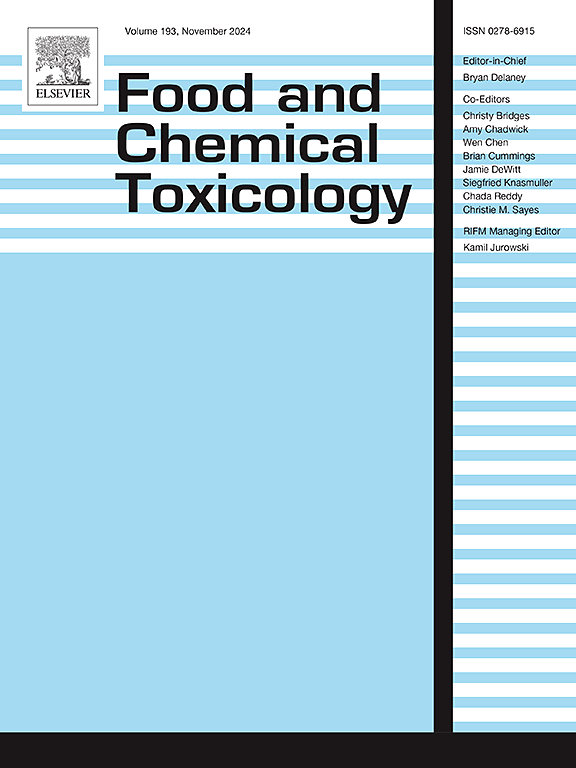岩藻黄素恢复线粒体生物能量和减轻地塞米松诱导的成骨细胞功能障碍:糖皮质激素相关骨疾病的意义
IF 3.9
3区 医学
Q2 FOOD SCIENCE & TECHNOLOGY
引用次数: 0
摘要
地塞米松(Dexamethasone, DEX)是一种广泛使用的抗炎糖皮质激素,与骨骼相关的不良反应有关。本研究探讨了生物活性类胡萝卜素岩藻黄素(FX)对dex诱导的人成骨细胞生物能量破坏的保护作用。DEX降低成骨细胞活力(48 h EC50 = 20 μM), FX (10-20 μM)抵消了此作用。DEX (2-20 μM)损伤成骨细胞功能,表现为I型前胶原、骨钙素和碱性磷酸酶分泌减少,ATP水平降低,线粒体膜电位(MMP)降低,耗氧量(OC)降低。DEX还能提高乳酸产量,抑制线粒体复合物I和III的活性,下调线粒体基因(ND1、ND5、细胞色素b、细胞色素c氧化酶、ATP合成酶亚基6/8)的表达。此外,DEX增加线粒体膜流动性、肿胀和H+/K+通透性。FX以剂量依赖性减弱了这些影响,恢复了活力、分泌功能和生物能量参数(ATP、MMP、OC),同时减轻了线粒体结构和离子干扰。这些发现强调了FX通过保持线粒体完整性和生物能量学来减轻dex诱导的成骨细胞功能障碍的潜力,表明其在治疗糖皮质激素相关骨疾病方面的治疗效用。本文章由计算机程序翻译,如有差异,请以英文原文为准。
Fucoxanthin restores mitochondrial bioenergetics and attenuates dexamethasone-induced osteoblast Dysfunction: Implications for glucocorticoid-associated bone disorders
Dexamethasone (DEX), a widely used anti-inflammatory glucocorticoid, is associated with bone-related adverse effects. This study investigated the protective role of fucoxanthin (FX), a bioactive carotenoid, against DEX-induced bioenergetic disruption in human osteoblasts. DEX reduced osteoblast viability (48 h EC50 = 20 μM), which FX (10–20 μM) counteracted. DEX (2–20 μM) impaired osteoblast function, marked by decreased secretion of procollagen type I, osteocalcin, and alkaline phosphatase, alongside reduced ATP levels, mitochondrial membrane potential (MMP), and oxygen consumption (OC). DEX also elevated lactate production, suppressed mitochondrial complexes I and III activities, and downregulated mitochondrial gene expressions (ND1, ND5, cytochrome b, cytochrome c oxidase, ATP synthase subunits 6/8). Additionally, DEX increased mitochondrial membrane fluidity, swelling, and H+/K+ permeability. FX attenuated these effects dose-dependently, restoring viability, secretory function, and bioenergetic parameters (ATP, MMP, OC) while mitigating mitochondrial structural and ionic disturbances. These findings highlight FX's potential to alleviate DEX-induced osteoblast dysfunction by preserving mitochondrial integrity and bioenergetics, suggesting its therapeutic utility in managing glucocorticoid-associated bone disorders.
求助全文
通过发布文献求助,成功后即可免费获取论文全文。
去求助
来源期刊

Food and Chemical Toxicology
工程技术-毒理学
CiteScore
10.90
自引率
4.70%
发文量
651
审稿时长
31 days
期刊介绍:
Food and Chemical Toxicology (FCT), an internationally renowned journal, that publishes original research articles and reviews on toxic effects, in animals and humans, of natural or synthetic chemicals occurring in the human environment with particular emphasis on food, drugs, and chemicals, including agricultural and industrial safety, and consumer product safety. Areas such as safety evaluation of novel foods and ingredients, biotechnologically-derived products, and nanomaterials are included in the scope of the journal. FCT also encourages submission of papers on inter-relationships between nutrition and toxicology and on in vitro techniques, particularly those fostering the 3 Rs.
The principal aim of the journal is to publish high impact, scholarly work and to serve as a multidisciplinary forum for research in toxicology. Papers submitted will be judged on the basis of scientific originality and contribution to the field, quality and subject matter. Studies should address at least one of the following:
-Adverse physiological/biochemical, or pathological changes induced by specific defined substances
-New techniques for assessing potential toxicity, including molecular biology
-Mechanisms underlying toxic phenomena
-Toxicological examinations of specific chemicals or consumer products, both those showing adverse effects and those demonstrating safety, that meet current standards of scientific acceptability.
Authors must clearly and briefly identify what novel toxic effect (s) or toxic mechanism (s) of the chemical are being reported and what their significance is in the abstract. Furthermore, sufficient doses should be included in order to provide information on NOAEL/LOAEL values.
 求助内容:
求助内容: 应助结果提醒方式:
应助结果提醒方式:


